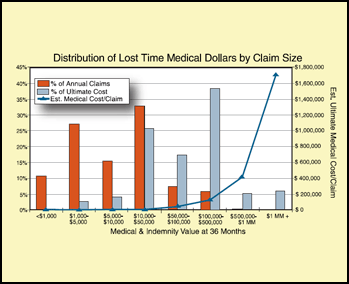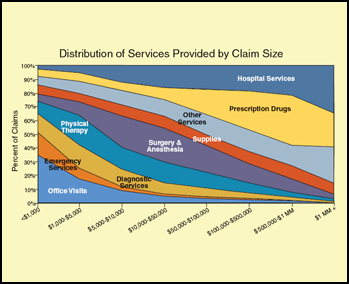| Prescription drugs account for over 19% of the medical cost of workers’ compensation claims, the single largest cost item in a recent study of claims published by the National Council on Compensation Insurance. The analysis evaluated claims from 2001-2003 at 36 months of maturity, ranging from under $1,000 to more than $1 million for medical and indemnity combined. |
| |
| The research confirms what has been intuitively obvious…small claims have a different cost makeup from large ones, but the finding that prescription drugs comprise such a large share of medical costs is somewhat surprising. |
| |
| The nearby graph compares the annual claim count versus the dollar size for medical and indemnity combined, and the average medical claim within each cost category. Nearly 55% of all claims are under $10,000 for medical and indemnity combined, with an average
medical claim size of $2,300. However, these claims represent only 6.9% of the total dollar value of claims filed for accidents which occurred 2001-2003. |
| |
| While claims in excess of $100,000 (medical plus indemnity) comprise only 6% of the number filed, they account for 40% of the cost, and for large claims, the average size of the medical portion is huge. Medical costs typically comprise 60% of the total cost of workers’ compensation claims. |
| |
| The major impact of pharmaceuticals on the total medical cost burden is clearly evidenced in the nearby graph. For claims with an aggregate value of $50,000-$100,000, prescription drug costs account for 19.1% of total medical expenses, and this share of total costs increases sharply as the size of the claim increases. Drugs account for 28.9% of total medical costs when claims are $100,000-$500,000, and 36.7% of claims $500,000-$1 million. |
| |
| The cumulative change in the consumer price index for medical care from January 1999 to January 2009 was 50%, compared to only 28% for all items. Corporations are advised to understand the workers’ compensation environment before picking a location for a new manufacturing plant or distribution center. Not only do
companies pay dearly after a claim is filed, but the cost of the insurance is high, and varies considerably from state to state. Within the 48 contiguous states,
Montana and Ohio have the highest average workers’ compensation premiums at $3.50 and $3.32 per hundred dollars of payroll, respectively. North Dakota at $1.08 per hundred, and Indiana at $1.23 per hundred, have the lowest average premiums. |
| |
|
|
|
| The fact two adjacent states, Ohio and Indiana, are at opposite ends of the cost continuum on this important business expense underscores the significant geographic variability of selected costs, even between locations that are very close to one another. |
| |
 |
| [Place cursor over graph to enlarge] |
| |
| |
 |
| [Place cursor over graph to enlarge] |
| |
| |
|